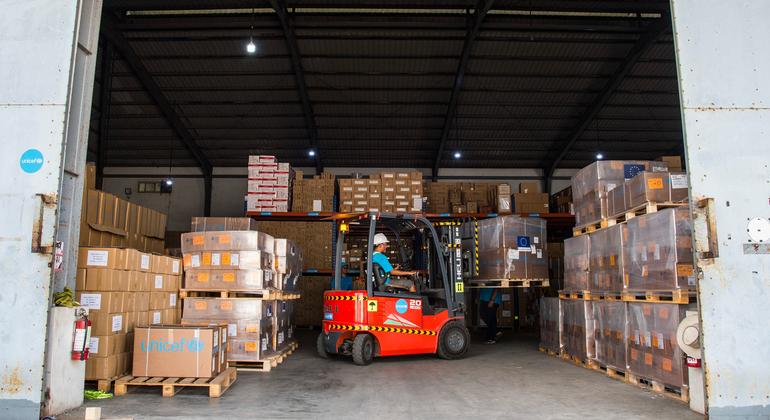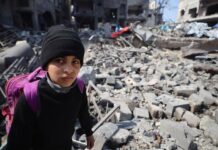“In the days following the deadly earthquake that tore through central Myanmar last week, the Myanmar military continued operations and attacks, including airstrikes – some of which were launched shortly after tremors subsided,” said Ravina Shamdasani, spokesperson for the High Commissioner for Human Rights.
“We urge a halt to all military operations and for the focus to be on assisting those impacted by the quake,” she told journalists in Geneva, reiterating Mr. Türk’s call for an “inclusive political solution” to end more than four years of fighting sparked by the junta’s February 2021 coup d’état.
Latest data from the UN human rights office, OHCHR, points to at least 61 reported attacks across Myanmar since the disaster happened, including 16 since the ceasefire announced by the military took effect on 2 April.
The tactics of the military – known as the Tatmadaw in Myanmar – include using near-silent adapted paragliders to bomb communities, said James Rodehaver, Head of OHCHR’s Myanmar team: “What those are is an individual military operative who uses a hang-glider with a backpack attached to his back or to his torso with a large fan on it and he uses that to essentially paraglide using the fan as a motor over areas and drop hand-held bombs or munitions onto targets below.”
Widespread needs
The development follows an urgent call by UN Secretary-General António Guterres for immediate and unrestricted humanitarian access to the country after the disaster claimed more than 3,000 lives and left millions in urgent need of aid.
Speaking to reporters at UN Headquarters in New York, the UN chief warned that the earthquake had “supercharged the suffering”. “Myanmar today is the scene of utter devastation and desperation,” he said.
The regions most impacted by the earthquake which struck at approximately 12.50pm local time on 28 March are Mandalay – the country’s second city and home to 1.2 million people – Sagaing, Nay Pyi Taw, Bago, Magway, Shan South and East.
Assessments have shown widespread destruction across central Myanmar to critical infrastructure – including health facilities, road networks and bridges.
In an update, the UN World Health Organization also reported that electricity and water supplies remain disrupted, worsening access to health services and heightening risks of waterborne and foodborne disease outbreaks.
The UN refugee agency, UNHCR – which issued an appeal on Friday for $16 million to support 1.2 million survivors – said that up to 80 per cent of structures in Mandalay are estimated to have collapsed.
Access obstacles
UNHCR spokesperson Babar Baloch explained that the UN agency has already deployed existing emergency relief including plastic sheets and kitchen sets for 25,000 survivors in Mandalay, Sagaing and Bago regions, as well as the capital, Nay Pyi Taw, and parts of Shan State.
UN partner the International Committee of the Red Cross (ICRC) meanwhile reported that 136 townships have been affected by the earthquake “and about 25 per cent are in areas not controlled by the Government, so that’s complicating the access”.
Echoing those concerns, Ms. Shamdasani from the UN human rights office said that the scale of the disaster had been made worse by the information blackout caused by internet and telecommunications shutdowns “imposed by the military”.














 English
English French
French Spanish
Spanish German
German Dutch
Dutch Italian
Italian Danish
Danish Portuguese
Portuguese Greek
Greek Russian
Russian Swedish
Swedish Bulgarian
Bulgarian Hungarian
Hungarian Catalan
Catalan Ukrainian
Ukrainian Polish
Polish Basque
Basque Chinese (Simplified)
Chinese (Simplified) Japanese
Japanese Hebrew
Hebrew Arabic
Arabic Swahili
Swahili Amharic
Amharic Irish
Irish Afrikaans
Afrikaans Albanian
Albanian Armenian
Armenian Azerbaijani
Azerbaijani Belarusian
Belarusian Bengali
Bengali Bosnian
Bosnian Cebuano
Cebuano Chichewa
Chichewa Chinese (Traditional)
Chinese (Traditional) Corsican
Corsican Croatian
Croatian Czech
Czech Esperanto
Esperanto Estonian
Estonian Filipino
Filipino Finnish
Finnish Frisian
Frisian Galician
Galician Georgian
Georgian Gujarati
Gujarati Haitian Creole
Haitian Creole Hausa
Hausa Hawaiian
Hawaiian Hindi
Hindi Hmong
Hmong Icelandic
Icelandic Igbo
Igbo Indonesian
Indonesian Javanese
Javanese Kannada
Kannada Kazakh
Kazakh Khmer
Khmer Korean
Korean Kurdish (Kurmanji)
Kurdish (Kurmanji) Kyrgyz
Kyrgyz Lao
Lao Latin
Latin Latvian
Latvian Lithuanian
Lithuanian Luxembourgish
Luxembourgish Macedonian
Macedonian Malagasy
Malagasy Malay
Malay Malayalam
Malayalam Maltese
Maltese Maori
Maori Marathi
Marathi Mongolian
Mongolian Myanmar (Burmese)
Myanmar (Burmese) Nepali
Nepali Norwegian
Norwegian Pashto
Pashto Persian
Persian Punjabi
Punjabi Romanian
Romanian Samoan
Samoan Scottish Gaelic
Scottish Gaelic Serbian
Serbian Sesotho
Sesotho Shona
Shona Sindhi
Sindhi Sinhala
Sinhala Slovak
Slovak Slovenian
Slovenian Somali
Somali Sundanese
Sundanese Tajik
Tajik Tamil
Tamil Telugu
Telugu Thai
Thai Turkish
Turkish Urdu
Urdu Uzbek
Uzbek Vietnamese
Vietnamese Welsh
Welsh Xhosa
Xhosa Yiddish
Yiddish Yoruba
Yoruba Zulu
Zulu